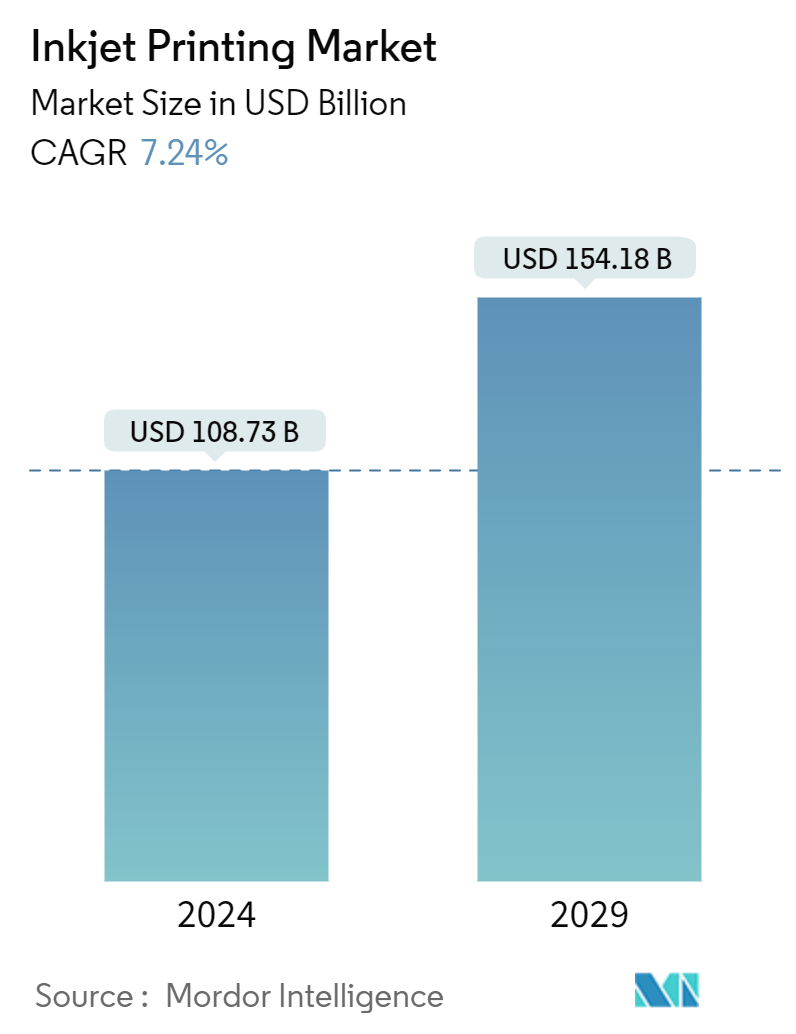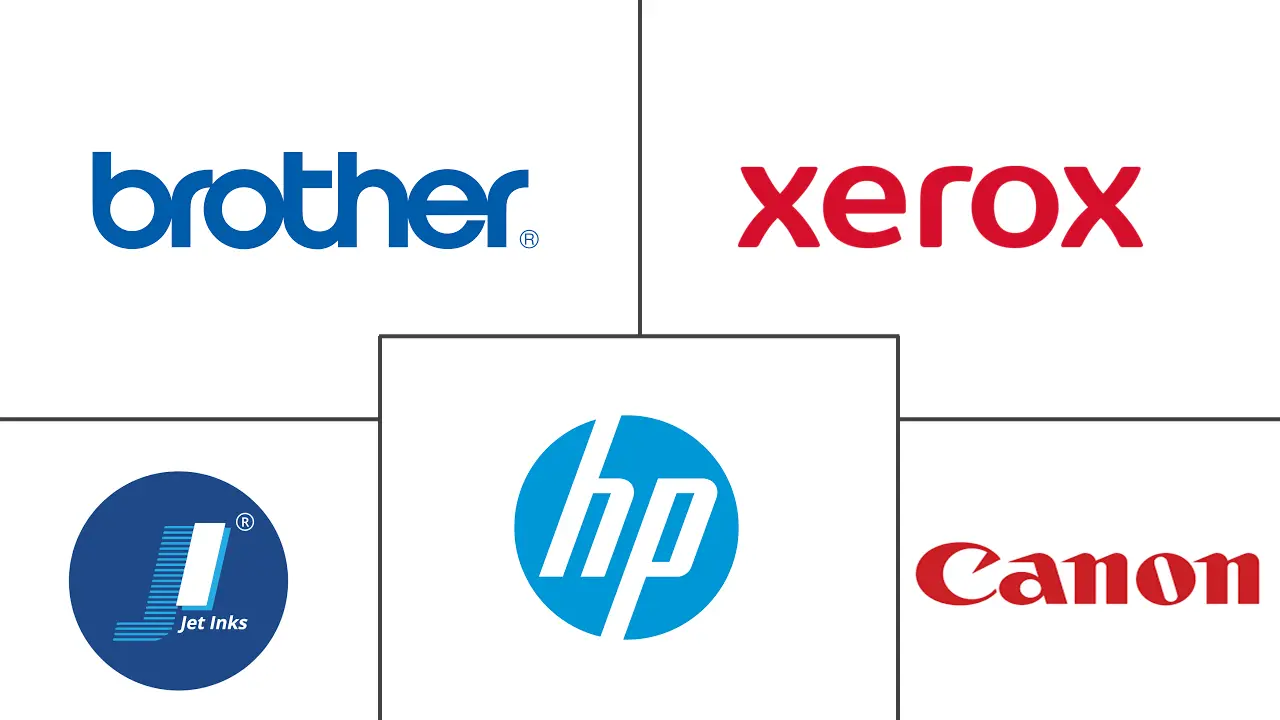Market Size of Inkjet Printing Industry

| Study Period | 2019 - 2029 |
| Market Size (2024) | USD 108.73 Billion |
| Market Size (2029) | USD 154.18 Billion |
| CAGR (2024 - 2029) | 7.24 % |
| Fastest Growing Market | Asia Pacific |
| Largest Market | North America |
| Market Concentration | Low |
Major Players
*Disclaimer: Major Players sorted in no particular order |
Inkjet Printing Market Analysis
The Inkjet Printing Market size is estimated at USD 108.73 billion in 2024, and is expected to reach USD 154.18 billion by 2029, growing at a CAGR of 7.24% during the forecast period (2024-2029).
- Inkjet printing, a method that disperses tiny droplets of liquid ink onto various surfaces such as paper, has been instrumental in the advancement of digital printing. This technique produces high-resolution images that rival traditional photographs. One of the most remarkable features of inkjet printing is its affordability. It provides exceptional flexibility and requires minimal initial investment, making it particularly suitable for economical, low-volume, and single-copy printing tasks. Inkjet printers are especially advantageous for the efficient production of short runs and customized products.
- The demand for ink in the inkjet printing industry is transforming its ecosystem. At present, solvent, water-based, and UV inks dominate the market, with LED inks also gaining ground. Despite being a well-established technology, inkjet printing is experiencing growing usage due to advancements in technology that are reshaping the role of print in communication, driven by personalization, integration, interactivity, mobility, and the need for diversification. Commercial printing has been a widely used method since the introduction of the printing press.
- The increasing need for UV-curable inks is a major factor influencing the inkjet printers market, especially in sectors like packaging. UV-curable inks also offer the benefit of being able to stick to a variety of surfaces. They can securely attach to different materials, such as plastics, glass, metal, and even unique surfaces like wood and ceramics. This flexibility enables printing on a wide range of substrates, broadening the potential applications of inkjet printers. These notable developments are projected to boost market growth.
- The integration of inkjet printing with digital innovations, including cloud computing, artificial intelligence, and the Internet of Things, is transforming the printing industry. Print heads equipped with IoT technology are improving operational efficiency by minimizing downtime through capabilities such as remote monitoring, diagnostics, and predictive maintenance. Additionally, software solutions driven by AI are boosting both efficiency and print quality by effectively managing color, processing images, and optimizing workflows.
- The growth of the inkjet printing market is being fueled by the increasing use of large-format printers, investments from various vendors, and the availability of a wide range of inks. In February 2024, HP introduced its HP Thermal Inkjet (TIJ) 108 mm Bulk Printing Solution, which aims to transform packaging processes in the industry with its efficient, adaptable, and environment-friendly printing technology. This new addition to the TIJ 4.0 Printhead technology offers high speeds, excellent resolution, and throw distances of up to 10 mm, making it suitable for a variety of wide-swath, high-volume printing tasks without the need for stitching.
- In commercial print applications, inkjet technology is becoming more prevalent. Wide-format and high-speed presses are now accompanied by high-quality sheet-fed inkjet presses. For example, in response to the shift toward electronic media and online shopping, book printing is increasingly utilizing inkjet printing. The single-pass web inkjet press plays a key role in this transformation, connecting mono and color presses to efficient cutting and folding systems to produce sections or blocks for near-line binding.
- In the field of printing technologies, inkjet printing is encountering strong competition from well-established methods like flexographic and screen printing. The slow expansion of flexographic printing indicates its strong presence in important industries, which in turn restricts the potential for inkjet technologies to gain a substantial market share. Inkjet printing, which is frequently linked to higher initial expenses and ongoing operational costs like ink cartridges, may find it challenging to compete in terms of cost per page, especially in environments with high-volume production.
Inkjet Printing Industry Segmentation
Inkjet printing is the most widely used form of digital printing for small, inexpensive consumer models and expensive professional machines. The market is defined by the revenue accrued from selling inkjet printing solutions worldwide. The inkjet printing market is segmented by application and geography. By application, the market is divided into books/publications, commercial printing, advertising, transactions, labels, packaging, and other applications. By geography, the market is segmented into North America, Europe, Asia-Pacific, Latin America, and Middle East and Africa. The market sizes and forecasts are provided in terms of value (USD) for all the above segments.
| By Application | |
| Books/Publishing | |
| Commercial Print | |
| Advertising | |
| Transaction | |
| Labels | |
| Packaging | |
| Other Applications |
| By Geography | |
| North America | |
| Europe | |
| Asia-Pacific | |
| Latin America | |
| Middle East and Africa |
Inkjet Printing Market Size Summary
The inkjet printing market is poised for significant growth, driven by its cost-effectiveness, versatility, and minimal setup requirements. This technology, which sprays tiny droplets of ink onto surfaces, has become integral to digital printing, offering high-quality images comparable to photographs. Inkjet printers are particularly advantageous for short runs and unique products, making them essential in the evolving commercial printing landscape. The market is further propelled by advancements in Big Data and IoT, which enhance production efficiency and real-time monitoring. Despite challenges in the paper industry and the need for manufacturers to adapt to technological changes, the demand for inkjet printing continues to rise, especially in packaging and e-commerce sectors.
The Asia-Pacific region, led by countries like China and India, is experiencing a surge in consumer spending, boosting demand for printed products. Technological advancements in digital printing are transforming the industry, attracting both SMEs and large businesses. The market is highly fragmented, with numerous players competing on price, including major companies like HP, Canon, and Xerox. Recent collaborations and innovations, such as Canon's partnership with Heidelberger Druckmaschinen AG and FUJIFILM's Jet Press FP790, highlight the industry's focus on hybrid production and flexible packaging solutions. These developments underscore the growing importance of inkjet printing in meeting dynamic market demands and enhancing operational efficiency.
Inkjet Printing Market Size - Table of Contents
-
1. MARKET INSIGHTS
-
1.1 Market Overview
-
1.2 Industry Attractiveness - Porter's Five Forces Analysis
-
1.2.1 Threat of New Entrants
-
1.2.2 Bargaining Power of Buyers
-
1.2.3 Bargaining Power of Suppliers
-
1.2.4 Threat of Substitute Products
-
1.2.5 Intensity of Competitive Rivalry
-
-
1.3 Value Chain Analysis
-
1.4 Assessment of the Impact of Key Macroeconomic Trends on the Market
-
-
2. MARKET SEGMENTATION
-
2.1 By Application
-
2.1.1 Books/Publishing
-
2.1.2 Commercial Print
-
2.1.3 Advertising
-
2.1.4 Transaction
-
2.1.5 Labels
-
2.1.6 Packaging
-
2.1.7 Other Applications
-
-
2.2 By Geography
-
2.2.1 North America
-
2.2.2 Europe
-
2.2.3 Asia-Pacific
-
2.2.4 Latin America
-
2.2.5 Middle East and Africa
-
-
Inkjet Printing Market Size FAQs
How big is the Inkjet Printing Market?
The Inkjet Printing Market size is expected to reach USD 108.73 billion in 2024 and grow at a CAGR of 7.24% to reach USD 154.18 billion by 2029.
What is the current Inkjet Printing Market size?
In 2024, the Inkjet Printing Market size is expected to reach USD 108.73 billion.

